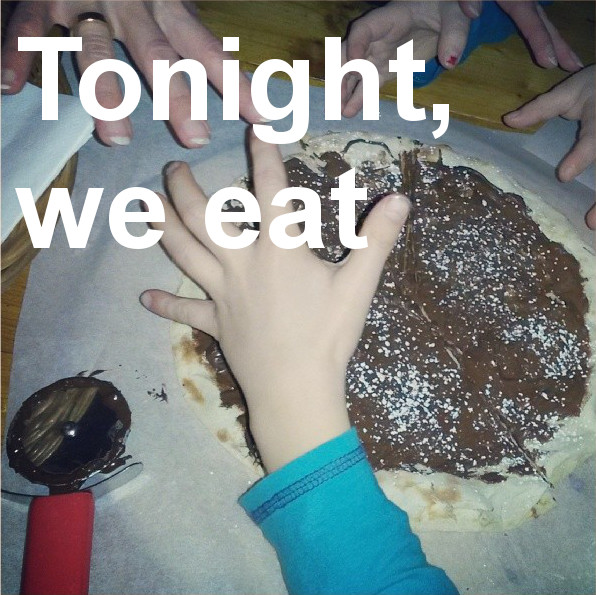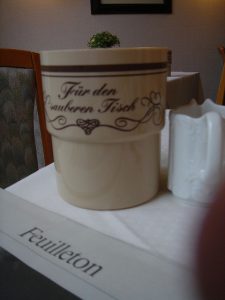After about 15 years in-country, I discovered yet another magical corner of Germany: The Nutella pizza. It happened after spontaneously hitting one of our favorite pizza joints in a Berlin neighborhood that might be Kreuzberg, Schöneberg or Tiergarten but is all parts great (I’m going to respect its privacy by just not checking).
“Ok,” I said to my fellow diners, who were comprised of a 9-year-old, a 10-year-old and my wife (age withheld). “Are we done? Can we go?”
My daughter picked up an errant Pizza Klub menu, stained by previous diners, and pointed at the thing she’d been waiting to point at the whole meal: Nutella pizza.

Angels began singing. Cloudy skies parted and a non-denominational spiritual of indeterminate sex spoke, making it clear we were ordering the Nutella pizza.
People seem to always give credit for Nutella to the country in which they first encounter it. Like a moustachioed turn-of-the-century hipster sampling Frites in Paris and making an incorrect assumption. I could google “Nutella history” and reword Ferrerro (Nutella’s owner) PR copy or copy and paste a Wikipedia entry but this post isn’t about Nutella’s origin story, it’s about my Nutella origin story. (And it’s 2016, you can do the googling yourself).
My first Nutella
I first encountered Nutella on my first-ever morning in Germany, back when the Kaisers still roamed the earth and Weimar was a town, not a historical period. After my guest parents taught me how to slice open a Brötchen and smear on Nutella (with butter, a practice I no longer follow), I figured they were allowing me a rare German treat because they were new guest parents and it was my first morning in Germany.
I mean, who has chocolate for breakfast? Unless it’s in a donut, of course.
But it wasn’t a special treat. I quickly came to realize that Nutella is a staple of the German diet behind Kartoffeln, Wurst and Weltschmerz. It’s always on the breakfast table, usually on a tray next to sugar beet syrup (Zuckerrübensyrup) and a jar of jelly last used during the Kohl administration.
I’m grateful to the Gehrings of Oldenburg for this introduction.
However, Nutella was one of the first child-rearing fights between my wife and I: She wanted to allow the children to have it while they were still in the womb but I argued it might give them too much of a taste for chocolate.
“Peanut butter, on the other hand,” I said.
Thanks, Pizza Klub
“It’s no different!” she claimed.
We all know she was wrong.
But by introducing them to Nutella so early, my daughter (and Pizza Klub) introduced me to the Nutella pizza.
So somehow my wife was right.
Leave a Comment




![6a00e54efdf112883301901e5534d3970b[1]](http://howifoughtthegermansandwon.com/wp-content/uploads/2016/01/6a00e54efdf112883301901e5534d3970b1.jpg)
![61Y5GM0WKRL._SX258_BO1%252C204%252C203%252C200_%255B1%255D[1]](http://howifoughtthegermansandwon.com/wp-content/uploads/2016/01/61Y5GM0WKRL._SX258_BO1252C204252C203252C200_255B1255D1.jpg)
![50yearcalendar%255B1%255D[2]](http://howifoughtthegermansandwon.com/wp-content/uploads/2016/01/50yearcalendar255B1255D2.jpg)
![tumblr_inline_nzkq3sFpWx1sqqghr_500%255B1%255D[1]](http://howifoughtthegermansandwon.com/wp-content/uploads/2016/01/tumblr_inline_nzkq3sFpWx1sqqghr_500255B1255D1.jpg) I came from a country where train delays weren’t measured in minutes or even hours but rather days. In my childhood, American passenger trains were never delayed by things like inclement weather or suicidal twenty-somethings. They seemed to suffer from depression, only getting up the nerve to traverse the country after a couple of stiff whiskeys and a stern talking to by the Minister of Transportation.
I came from a country where train delays weren’t measured in minutes or even hours but rather days. In my childhood, American passenger trains were never delayed by things like inclement weather or suicidal twenty-somethings. They seemed to suffer from depression, only getting up the nerve to traverse the country after a couple of stiff whiskeys and a stern talking to by the Minister of Transportation.![tumblr_inline_nzkos3mfDR1sqqghr_500%255B1%255D[1]](http://howifoughtthegermansandwon.com/wp-content/uploads/2016/01/tumblr_inline_nzkos3mfDR1sqqghr_500255B1255D1.jpg)
![tumblr_inline_nzkossZHc51sqqghr_500%255B1%255D[1]](http://howifoughtthegermansandwon.com/wp-content/uploads/2016/01/tumblr_inline_nzkossZHc51sqqghr_500255B1255D1.jpg)